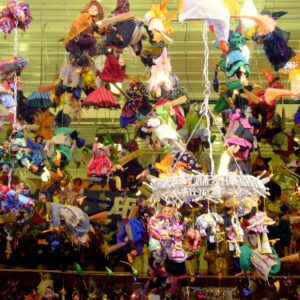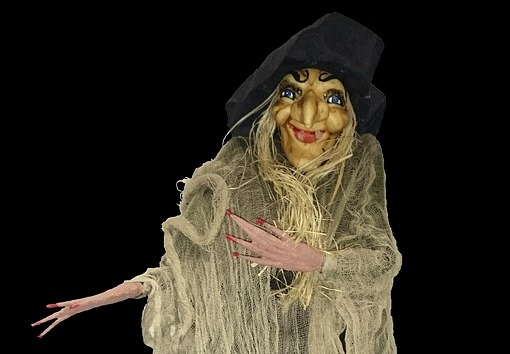When I moved to Rome in 1970 there were no advent calendars (I brought them to my very appreciative nephews from New York), no Christmas trees (not even in St. Peter’s Square or Piazza Venezia) and no Santa Claus, because all three are Northern European customs. I felt like a Martian especially because the postal system slowed to a snail pace, so I didn’t receive any season greetings until mid-January.
Even when Santa Claus started to creep in during the early eighties, little attention was paid to his traditional size. His doubles were usually disappointingly skinny and carried no bell. The holiday season, like today, began on December 8, the Immaculate Conception, but with families setting up their crèches, not decorating trees. Christmas Day itself was a religious, not a commercial, holiday with family: a fish dinner on Christmas Eve, midnight Mass; then on the 25th morning Mass with the Pope’s message afterwards on TV and a huge meal followed by an afternoon of family card or board games. Children received their stocking and presents on Epiphany.
The End of the Holidays
Epiphany, from the Greek word for “manifestation or appearance of God”, is celebrated on January 6 with a national holiday in Italy and the tradition of La Befana. It commemorates the 12th day of Christmas when the Three Kings or Wise Men arrived at the manger bearing gifts for baby Jesus. It also marks the date of Jesus’s baptism 30 years later, and of the Wedding of Cana. Italy’s Christmas holiday season ends with Epiphany. Hence the saying: “L’Epifania tutte le feste si porta via” or “The Epiphany sweeps away all the festivities.” No to worry though, Epiphany marks the beginning of carnevale, but that’s another story.

La Befana is the tale of the good hag wearing a kerchief tied under her chin, a crocheted shawl, a tattered dress and shoes and stockings full of holes. She arrives on her broomstick during the night of January 5th and fills stockings with toys and sweets for good children and lumps of coal for naughty ones, in return for a glass of wine.
A Crone or a Lost Woman
According to her legend, the night before the Wise Men (Caspar from Tharis bearing gold, the symbol of Christ’s Kingship; Balthasar from Gedaliah bearing frankincense, the symbol of His divinity because it was already used in religious ceremonies; and Melchior from Nubia bearing myrrh, the symbol of His mortal humanity because it was used during burials) arrived at the manger, they stopped at the shack of an old woman to ask directions.

She offered them shelter for one night. The next morning they invited her to come with them, but she replied that she was too busy doing her housework. Then a shepherd asked her to come with him, but again she refused. Later, that night she saw a bright light in the sky and decided to join the Wise Men and the shepherd. Unfortunately, she got lost and still hasn’t found the manger.
The origins of La Befana probably go back to the Romans’ pagan festival of Saturnalia, a one-or-two-week-long festival starting just before the winter solstice. At the end of Saturnalia, the ancient Romans would go to the Temple of Juno on the Capitoline Hill to have their augurs read by an old crone. Many pagan traditions were incorporated into Christmas celebrations when Christianity became mainstream.
Festivals around Italy

Befana festivals take place in many parts of Italy, especially in the former Papal States of the Marche, Umbria, and Latium. The most famous, though in 2015 and 2016 reduced in size, is Rome’s Befana Market in Piazza Navona with its dozens of stalls selling crèche figures, sweets and carbone (black spun sugar coal) for the Befana’s stocking. Elsewhere in Rome at the Casina di Raffaello, in the Villa Borghese Park, Epiphany is celebrated with shows and magic workshops, jugglers and street artists from 11 AM to 5 PM. Entrance free. There’s also Rome’s Befana Village with sweets, cotton candy, carbone, clowns, puppets, and lots of befanas at Piazza Capecelatro (reachable by the 46 or 49 bus). Entrance free.
Near Rome, in Viterbo, there are shows and street theater for kids from 4 PM, accompanied by the Bersaglieri (The Army’s Infantry Regiment) Band, while at 5 PM, the traditional firefighter Befana arrives. At 9 PM this year the Happy Day Gospel Singers will perform in St. Lawrence Cathedral.
In Fiumicino, the city near Rome’s main airport, the 13th edition of Epiphany celebrations will take place. These include rides with the Befana in old cars and tractors, the ugliest Befana contest and candies galore.

Far from Rome, the town of Urbania in the Marche region, officially the Befana’s hometown, every year holds a four-day festival, one of the biggest in Italy, for La Befana from January 2-6. This year for the 7th time, another, Il Grande Raduno Nazionale delle Befane e dei Befani (The Grand National Meeting of all Befane and Befani), with over 1,000 hags of both sexes in attendance and fun for all: sports, singing, and dance competitions, games, car rallies, amusement rides, street food, Befane markets, and even a Befana Beauty contest will take place on the 5-6 in Fornovo di Taro outside Parma. Since the 1970s in Venice men dressed as La Befana compete in the Regatta della Befana on the Grand Canal.
In the past roast lamb was Epiphany’s traditional dish, now besides ubiquitous carbone, in the Veneto it’s pinza or cross between panettone and Sienese panforte and in Naples struffoli or tiny balls of fried dough covered with honey and multi-colored sprinkles.
Elsewhere in Italy Epiphany is celebrated with a religious procession. In Vatican City every year at 11 AM hundreds of people dressed in medieval costumes follow behind the three Wise Men on horseback up Via della Conciliazione to St. Peter’s Square where the Pope performs a commemorative mass. In Florence the historical procession, known as the Cavalcata dei Magi, usually starts from the Palazzo Pitti in the early afternoon and crosses the Arno River to the Duomo. On the way, flag throwers perform in Piazza della Signoria. In Milan a similar procession goes from the Duomo to the Church of San’Eustorgio not to mention the procession in historical costume in Rivisondoli, a picturesque town in the Abruzzi.












